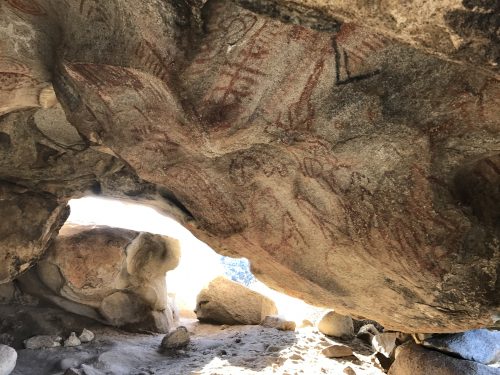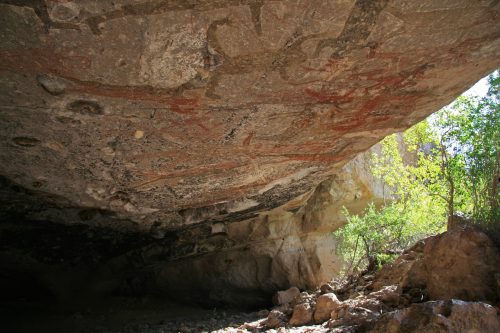Some of Baja’s most impressive attractions are the numerous cave painting sites scattered throughout the peninsula. These ancient creations are a unique window into the native peoples and cultures that occupied the peninsula thousands of years ago, and an awe-inspiring look at some of the first art in the Americas. Historians, anthropologists, art enthusiasts, and Baja adventurers have been seeking out the sites since they were first unveiled to the Western world in the 1960s. We bring you five of our favorites.
El Vallecito
Location: La Rumarosa, BC
Why We Love It: El Vallecito is one of the easiest cave painting sites to visit on the peninsula, and can be visited in a day trip from San Diego. Located near the town of La Rumarosa between Tecate and Mexicali, the five sites are connected via a two-mile walking trail.
What it’s Famous For: The most famous of the cave paintings at El Vallecito is “El Diablo,” a painting of a small devil. During the winter solstice, a ray of sunlight enters the cave and is said to illuminate the devil’s eyes.
How to Visit: From Tecate, head east on Highway 2D and get off at the town of La Rumarosa. Follow the signs to the site, located just north of the highway. You’ll pay 45 pesos per person for admission (and an extra 45 pesos to take photos) and will receive a map of the sites to guide you as you walk the trail. Open 8am-5pm, Wed-Sun.
DBTC Insider Tip: While El Diablo takes a lot of the fame, the Cueva del Indio/El Hongo site is the most impressive of the group.
Cataviña
Location: Cataviña, BC
Why We Love It: Easy to visit, these cave paintings are just off of Mexico 1 a few kilometers north of Hotel Misión in Cataviña. The rock art at Cataviña is a popular spot for many travelers because of the easy and fast accessibility. The paintings are believed to have been created by the Cochimi people about 1,000 years ago.
What it’s Famous For: The colorful rock paintings are tucked inside a small cave and depict geometric designs, a sun, and other abstract graphic shapes. The yellow, red, and black paint colors were made from local minerals.
How to Visit: On Mexico 1 at Km. 176, watch for the INAH sign on the east side of the highway. You can park your car here to begin the easy 10-minute hike up the hill to the cave paintings. The trail is well marked (follow the yellow arrows) and has historical and informational signs about the region and the indigenous people.
DBTC Insider Tip: This is one of the few places on the peninsula where you can spy a few of the rare Mexican Blue Palms, which have a dusty gray/blue hint to their fronds.
Sierra de San Francisco
Location: Sierra de San Francisco, North of San Ignacio, BCS
Why We Love It: One of the most impressive and unique experiences in Baja California is the cave paintings of the Sierra de San Francisco. This UNESCO World Heritage area concentrates some of the best-preserved and most impressive rock art sites in the world, known as the “great murals.” 400 sites have been recorded in the region and most of the sites remain intact and in good condition. The good condition of the rock art is attributed to the dry climate and remote, inaccessible location. Set in a seies of steep canyons, visitors will find rock cave shelters and huge panels decorated with depictions of human figures as well as marine and land wildlife, painted in red, black, white, and yellow.
What it’s Famous for: While the Sierra de San Francisco is home to numerous notable rock art sites, the most impressive site on the whole peninsula is Cueva Pintada. The size of the cave and the durability of the paintings that have survived, make it remarkable. At 100 feet long with more than 40 figures, the site is one of Baja’s best treasures.
How to Visit: All visitors to the rock art must be registered with INAH, Mexico’s National Institute of Anthropology and History, and have a guide. You can either book a guide directly in the town of San Francisco through the Buenaventura Hostel (tel. 615/156-4747, (www.sierrasanfrancisco.com) or you can go with a tour outfitter like Kuyima (615/154-0070, www.kuyima.com) in San Ignacio. While it’s possible to do day trips to see some of the rock art, in order to see the best sites and get the full experience, it’s necessary to dedicate 3-4 days to visiting the cave paintings. The best rock art is only reached through a journey of hiking and riding a pack animal while camping in the sierras.
DBTC Insider Tip:
It’s too hot to go down into the canyons June-September. April, May, and October are the best months to visit.
San Borjitas
Location: Sierra de Guadalupe, Northwest of Mulegé, BCS
Why We Love It: Carbon-dated to be 7,500 years old, these are believed to be the oldest cave paintings in North America, and they are also some of the most impressive in Baja California. These are the most impressive cave paintings on the peninsula that can be visited in a day trip.
What it’s Famous for: The canvas for the paintings is a 30-meter long cave overhang with the ceiling containing over 80 monos (human figures). The monos are bi-colored, with one half painted in black and the other half in red. Monos also appear at right angles to one another, forming an open network of bodies loosely woven together, another distinguishing feature for the San Borjitas paintings.
How to Visit: To get to San Borjitas, you can hire a guide in Mulegé or head out to Rancho Las Tinajas on your own and hire a guide to take you directly to the site from there. Getting to Rancho Las Tinajas involves a rigorous 30 kilometer, 2.5 hour off-road drive through riverbeds, deep sand, and large rocks. The drive should not be attempted without a high-clearance, four-wheel-drive vehicle. A 20-minute hike is required to reach the cave paintings.
DBTC Insider Tip: If you have a highly-capable four-wheel-drive vehicle and a spirit for adventure, you can drive out to Rancho Las Tinajas on your own and hire a guide to take you to the site from there. The turn off for Rancho Las Tinajas and The San Borjitas cave paintings is at Km. 165 on Mexico 1. This is one of the best single-day Baja adventures to be had on the peninsula, with an impressive reward at the end.
La Trinidad
Location: Sierra de Guadalupe, West of Mulegé, BCS
Why We Love It: This is another cave painting site that can be visited from Mulegé in a day trip, either venturing out on your own or by hiring a guide from Mulegé.
What it’s Famous for: The paintings feature a collection of animal depictions, including a famous painting of a large orange deer with a checkerboard pattern. The deer is a recurring theme in prehistoric rock art throughout Baja and the La Trinidad deer is known for being the best example of the motif.
How to Visit: Visiting the cave paintings requires a permit from INAH and hiring a local guide. Guides can be hired from Mulegé or at Rancho La Trinidad, located 29 kilometers west of Mulegé. The ranch can be reached by car and from there you will hike in with a guide to the cave paintings. Most travelers hire a guide from Mulegé for the sake of convenience. For a guide from Mulegé, try Salvador Castro Drew (tel. 615/153-0232, cell tel. 615/103-5081, mulegetours@hotmail.com) or Ciro Cuesta (tel. 615/153-0566, cell tel. 615/106-8892)
DBTC Insider Tip: There are two groups of paintings at La Trinidad. It’s about a 45-minute hike to get to the first set and an extra hour to get to the second set. Many guides only take visitors to the first set, so inquire ahead of time when making arrangements if you want to see both sets of paintings.
Getting to La Trinidad cave paintings used to require a rigorous excursion of swimming through gorges and multiple river crossings. Since Hurricane Odile in September 2014, the trek has been dry, but conditions could change at any time so be sure to inquire ahead of time.




You should publish an annual DB calendar!
San Borjitas cave paintings were awesome! The road in did not require 4wd and looks like it’s been graded. Pictures on our Facebook page – https://www.facebook.com/pg/AwayWeWinnebago/photos/?tab=album&album_id=761497164228449
The turn-off to San Borjitas is at KM 156 and only took us 55 minutes with a small SUV (Alamo Rental VW Tuareg) to reach Rancho Las Tinajas. There is a sign to Southbound travelers for San Borjitas, but not for those coming from Mulegé. Stay to your left going in at the major fork about 1/2 way since there are no signs after leaving the highway. We paid 500 pesos to have a shepherd/cowboy from the ranch unlock the gate (loacared about 3km back from the ranch along the same road you drove in on). From the locked gate it is another 3km drive to where the road dead ends at some cattle pens and a 20min walk from there to the cave. We speak just enough Spanish to get the general idea, but if you want more speculation I’ve read that In-town guides willl charge as much as 3000mx/ person if you don’t feel ok driving to the ranch yourself.